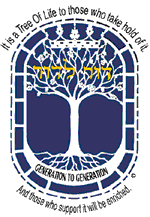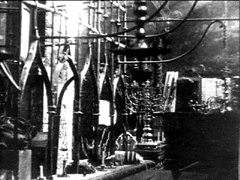|
|
The Story Of The Jewish Torahs of Czechoslovakia Chapter Three - "hundreds of corpses in transparent shrouds" The accessories of the scrolls also received careful attention. Cabinet makers were found who could repair wooden rollers so skillfully that the new parts seemed virtually indistinguishable from the originals. Some of the wimpels (strips of linen or other materials used to hold the scrolls together) were of historic interest because they bore, in embroidery, the name of the donor who had commissioned the writing of the scroll, and the date and occasion on which the scroll had been presented to its original synagogue. Wherever necessary, these wimpels were carefully washed, cleaned, and pressed by Mrs. Reinhart. From the time of their arrival in London, the scrolls, and their eventual availability to synagogues and other Jewish institutions in the Western world, received widespread publicity in the Jewish and non-Jewish press. Hundreds of visitors flocked to Kent House to view them. To one awe-stricken Czech Christian, they looked at first glance like "hundreds of corpses in transparent shrouds." Later, becoming calmer, he described them as "a mountain of dead books, spiritual bodies, so to speak, and yet a mountain glowing with the life of revelation, law, promise." Some Holocaust survivors and former refugees from Central Europe broke down and wept at the sight of the scrolls.
Before long, the Memorial Scrolls Committee was deluged with requests from synagogues, Jewish organizations, and private individuals all over the Western world for a Torah scroll from Czechoslovakia. The committee established a procedure for dealing with these requests that is followed to this day: "Each application must be submitted in writing to the committee for consideration. Priority is given to small congregations, homes for the aged, hospitals, and children's camps. Scrolls are never offered for sale; they are only given on "permanent loan." If the congregation or institution ceases to exist, its scroll must be returned to the Westminister Synagogue. In order to help cover expenses, the recipients are asked to make a contribution. In some instances, the amount is to be paid in installments. For deserving cases, it may be waived altogether, but such losses are more than offset by congregations sending contributions far in excess of the amount set by the committee." To one awe-stricken Czech Christian, they looked at first glance like "hundreds of corpses in transparent shrouds." Later, becoming calmer, he described them as "a mountain of dead books, spiritual bodies, so to speak, and yet a mountain glowing with the life of revelation, law, promise." Each scroll sent away bears a small brass plaque attached to its rollers with the inscription "Westminister Synagogue," the date 5725, i.e., 1964, "Czech Memorial Scroll," and the scroll's number. The scroll is accompanied by a certificate stating that it is one of the 1,564 scrolls from the Jewish ceremonial treasures confiscated by the Nazis, and giving in Hebrew and English the name of the town from which it came. Frequently, the Memorial Scrolls Committee receives letters from rabbis or Hebrew school students, requesting a history of the Czech community from which "their" scroll came. In the United States, representatives of the Society for the History of Czechoslovak Jews have participated in dedication exercises for the scrolls at various synagogues and supplied historical information on the Jewish communities where the scrolls had originated. For this purpose the society formed a special committee under the chairmanship of Gertrude Hirschler, author of the book The Jews of Czechoslovakia, from which the text for these chapters was reprinted. As of 1981 (the date of the most recent report issued by the Memorial Scrolls Committee), a total of 1,297 scrolls had been catalogued. Of these, a total of 692 had been sent to various synagogues and other Jewish institutions in England and other countries as follows:
A History All Its Own Each of these Torah scrolls has a historyall its own. Among the Czech sifre Torah brought to the United States, there were several very old scrolls. Congregation Beth Israel in Charlottesville, Virginia. has a sifre Torah from Lostice, Moravia, which dates from the Eighteenth Century. On June 9, 1973, the Rego Park Jewish Center of Queens New York, installed into its Ark a scroll that originally had belonged to the synagogue of the town of Hostomice, Bohemia. This scroll had been written in the year 1700. Rabbi Z. David Levy of Temple B'nai Or in Morristown, New Jersey, found that the scroll received by his congregation had come from the Malvazinka Synagogue in Prague and was approximately 200 years old. The Marathon Jewish Community Center in Little Neck, Long Island was given a scroll from the historic Altneuschul Synagogue in Pragues. The Altneuschul (Old-new synagogue) was built in 1260. It still serves today as an active synagogue for the Jewish community of Prague. For a more complete list of congregations with Web pages dedicated to their torahs, visit The Czech Torah Network's links page - www.czechtorah.org/links.php. Contact Susan Boyer of The Czech Torah Network to link your torah story or Web site to our links page. The Historic Altneuschul Synagogue
in Prague, circa 1890s, The Philip M. Klutznick National Jewish Museum at B'nai B'rith headquarters in Washington, D.C., houses a Torah scroll from the synagogue of Slavkov u Brna, better known as Austerlitz. Written at the end of the Eighteenth Century, this scroll survived the famous battle in which, on December 2, 1805, Napoleon won the most brilliant military victory of his leadership. The Hebrew Congregation of St. Thomas, Virgin Islands, dates from the late Eighteenth Century. The scroll it received had served at the synagogue of Budyne nad Ohre, Bohemia, having been installed there about 1780. Some of the Czech scrolls reinforced a link between Czech Jewry
and the history of the Jews in the United States. In the Summer
of 1978, Temple Beth Emunah
of Brockton, Massachusetts received a sifre Torah from the town
of Rokycany, Bohemia, the hometown of Adolph Kraus of Chicago, Illinois.
Mr. Kraus had left Rokycany in 1865 at the age of fifteen to settle
in Chicago, where he had a distinguished career as a lawyer and
civic leader. |

© 1999-2006, The Czech Torah Network. All Rights Reserved.
The logo design was created by Risa Mandelberg and is being used with permission.
© 1997, the paperdoll company. All Rights Reserved.
For questions or comments about this Web site please e-mail The Czech Torah Network at czechtorah@aol.com.


